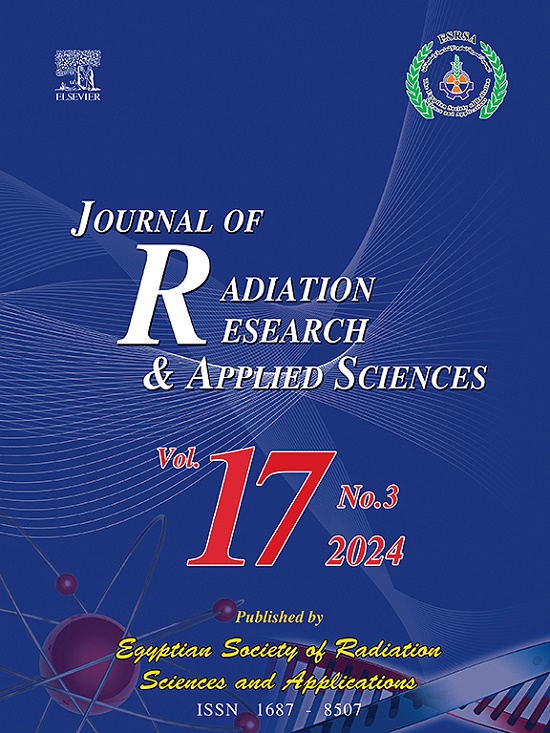利用迁移深度学习神经网络增强数字乳房x线摄影对女性乳腺癌的检测
IF 1.7
4区 综合性期刊
Q2 MULTIDISCIPLINARY SCIENCES
Journal of Radiation Research and Applied Sciences
Pub Date : 2025-03-12
DOI:10.1016/j.jrras.2025.101392
引用次数: 0
摘要
早期发现乳腺癌(BrC)是预防疾病扩散的最佳策略之一。这使得基于深度学习(DL)的自主诊断系统对提高检测和预测的准确性具有吸引力。本研究建议采用转移DL模型对乳房x线照片中的BrC进行分类。此外,为了识别BrC检测架构,将迁移深度学习模型应用于各种知名的卷积神经网络(cnn)。三个cnn (NasNetMobile, EfficientNet-b0和MobileNetV2)在使用前都经过特殊的调整。所有系统都使用两种类型的优化器:均方根传播(RMSP)和自适应矩估计(ADAM)。当使用ADAM优化器时,effentnet - 0网络的准确率为96.45%,灵敏度为96.63%,f1得分为97.18%。实验结果表明,EfficientNet-b0优于其他复杂的CNN技术,并提供了许多优势。此外,利用RMSprop优化器,EfficientNet-b0获得了96.00%的f1评分,96.55%的灵敏度和95.04%的准确性。综上所述,本工作通过将转移DL模型应用于数字乳房x线摄影扫描,提高了BrC的识别。在三个(NasNetMobile, EfficientNet-b0和MobileNetV2)中,性能最好的CNN是用ADAM和RMSprop优化的EfficientNet-b0。这些结果表明,这些结构可以改善医疗保健和提高BrC检测的准确性。本文章由计算机程序翻译,如有差异,请以英文原文为准。
Enhanced detection of female breast cancer from digital mammography employing transfer deep learning neural networks
Early detection of breast cancer (BrC) is one of the best strategies to prevent the disease's spread. This makes an autonomous diagnosis system based on deep learning (DL) attractive for improving the accuracy of detection and prediction. This study suggests employing transfer DL models to categorize BrC from mammograms. Furthermore, to identify BrC detection architectures, transfer DL models are applied to various well-known convolutional neural networks (CNNs). Three CNNs (NasNetMobile, EfficientNet-b0, and MobileNetV2) are adjusted in particular ways before being used. All systems use two types of optimizers: root mean square propagation (RMSP) and adaptive moment estimation (ADAM). The EfficientNet-b0 network attains 96.45% accuracy, 96.63% sensitivity, and 97.18% F1-score when using the ADAM optimizer. The experimental results demonstrate that EfficientNet-b0 outperforms other sophisticated CNN techniques and offers a number of advantages. Additionally, the EfficientNet-b0 obtained an F1-score of 96.00%, a sensitivity of 96.55%, and an accuracy of 95.04% utilizing the RMSprop optimizer. To sum up, this work improves the identification of BrC by applying transfer DL models to digital mammography scans. The best-performing CNN among the three (NasNetMobile, EfficientNet-b0, and MobileNetV2) was EfficientNet-b0 optimized with ADAM and RMSprop. These results show how these structures could improve healthcare and increase the accuracy of BrC detection.
求助全文
通过发布文献求助,成功后即可免费获取论文全文。
去求助
来源期刊

Journal of Radiation Research and Applied Sciences
MULTIDISCIPLINARY SCIENCES-
自引率
5.90%
发文量
130
审稿时长
16 weeks
期刊介绍:
Journal of Radiation Research and Applied Sciences provides a high quality medium for the publication of substantial, original and scientific and technological papers on the development and applications of nuclear, radiation and isotopes in biology, medicine, drugs, biochemistry, microbiology, agriculture, entomology, food technology, chemistry, physics, solid states, engineering, environmental and applied sciences.
 求助内容:
求助内容: 应助结果提醒方式:
应助结果提醒方式:


